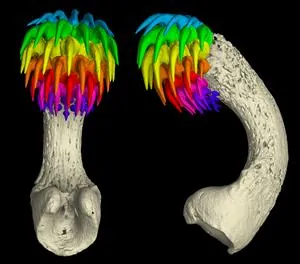
Meet the Ghost Shark: The Deep-Sea Creature with Teeth on its Forehead!
2025-09-04
Author: Mei
The Eerie Truth Behind Ghost Sharks
Ghost sharks, also known as chimaeras, are eerie deep-sea relatives of sharks and rays. But what's truly shocking is their strange anatomical feature — a rod protruding from their foreheads, adorned with sharp, retractable teeth. Research has uncovered that these aren’t just freaky decorations; they are actual rows of teeth growing outside the mouth.
Nature's Unique Mating Strategy
So, why do these ghostly fish have such a peculiar feature? New findings suggest that the dental growth on their foreheads, termed a tenaculum, plays a crucial role in mating. Unique to males, this peculiar appendage is utilized to grasp females during courtship, much like sharks use their toothy mouths.
Revolutionizing Our Understanding of Tooth Development
Gareth Fraser, Ph.D., a biology professor at the University of Florida and senior author of the study, stated, "If chimaeras can grow teeth outside their mouths, it challenges our understanding of tooth development altogether. Where else might we find teeth?" This innovative research, involving experts from the University of Washington and the University of Chicago, looked into both ancient fossils and living specimens to unravel this mystery.
Fossils Reveal Evolutionary Insights
Investigating a 315-million-year-old fossil revealed a tenaculum attached to the upper jaw, showcasing teeth strikingly similar to those found in the mouth. Living chimaeras from Puget Sound exhibited the same tooth development on their heads, akin to modern-day shark anatomy. Genetic tests confirmed these teeth expressed the same genes found in oral teeth.
A Fascinating Evolutionary Journey
Fraser noted that the teeth on the tenaculum resemble rows of shark teeth, suggesting a fascinating evolutionary journey where the ability to produce teeth moved from the mouth to this unique appendage. Initially longer, the tenaculum has shortened over time while retaining its tooth-generating capability.
Combining Modern Science and Paleontology
The groundbreaking study, published in the Proceedings of the National Academy of Sciences, combined experimental data and paleontological evidence. Researchers, including Karly Cohen, Ph.D., from the University of Washington, had never identified teeth located externally like this before.
A Testament to Evolution's Creativity
Cohen emphasized that the tenaculum represents a developmental relic, marking a significant instance of a toothed structure outside a jaw. This surprising transformation from oral teeth to forehead teeth illustrates evolution's remarkable flexibility, always ready to reconfigure biological structures for unexpected functions.
Endless Mysteries Beneath the Waves
Fraser concluded, "There are still countless surprises waiting for us in the ocean depths." Discoveries like the tenaculum remind us of the intricate and often bizarre paths evolution can take.



 Brasil (PT)
Brasil (PT)
 Canada (EN)
Canada (EN)
 Chile (ES)
Chile (ES)
 Česko (CS)
Česko (CS)
 대한민국 (KO)
대한민국 (KO)
 España (ES)
España (ES)
 France (FR)
France (FR)
 Hong Kong (EN)
Hong Kong (EN)
 Italia (IT)
Italia (IT)
 日本 (JA)
日本 (JA)
 Magyarország (HU)
Magyarország (HU)
 Norge (NO)
Norge (NO)
 Polska (PL)
Polska (PL)
 Schweiz (DE)
Schweiz (DE)
 Singapore (EN)
Singapore (EN)
 Sverige (SV)
Sverige (SV)
 Suomi (FI)
Suomi (FI)
 Türkiye (TR)
Türkiye (TR)
 الإمارات العربية المتحدة (AR)
الإمارات العربية المتحدة (AR)